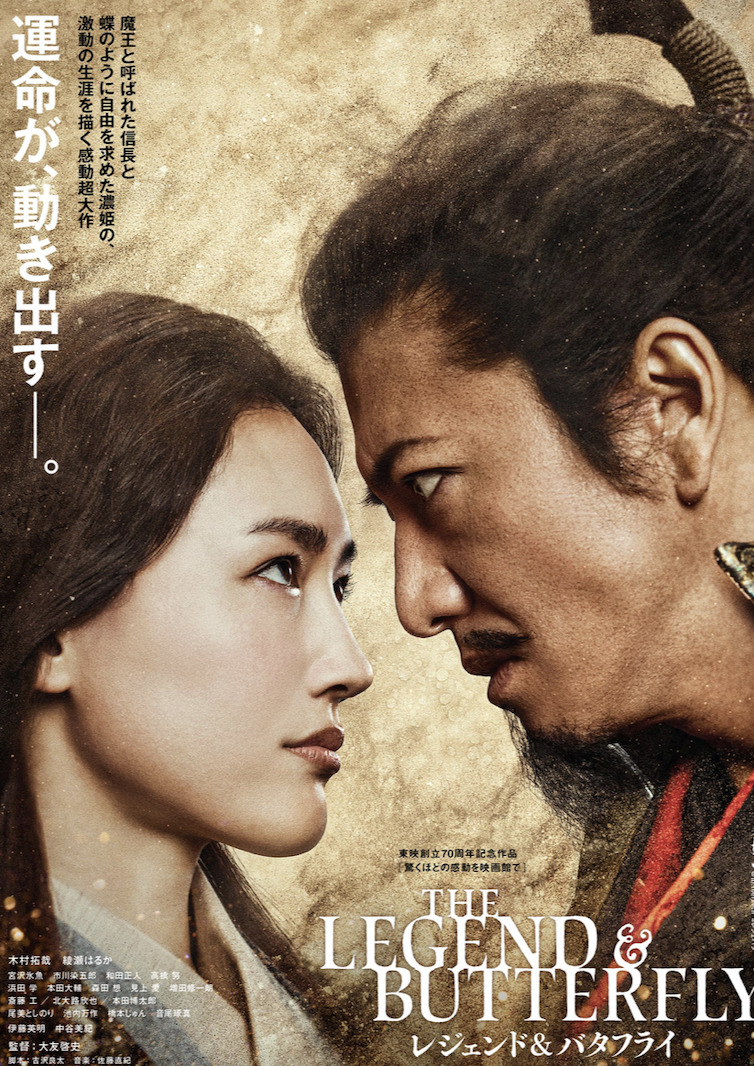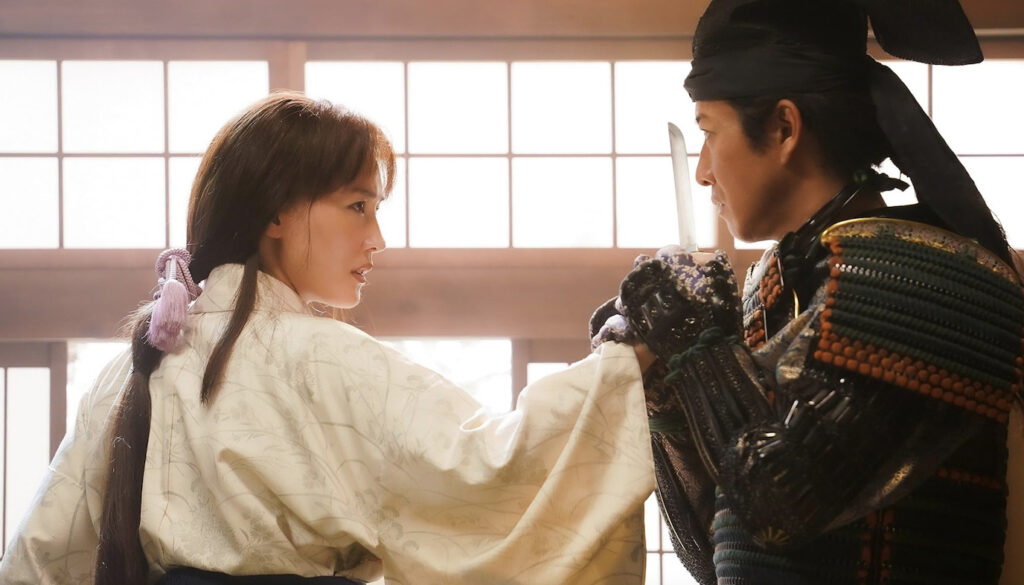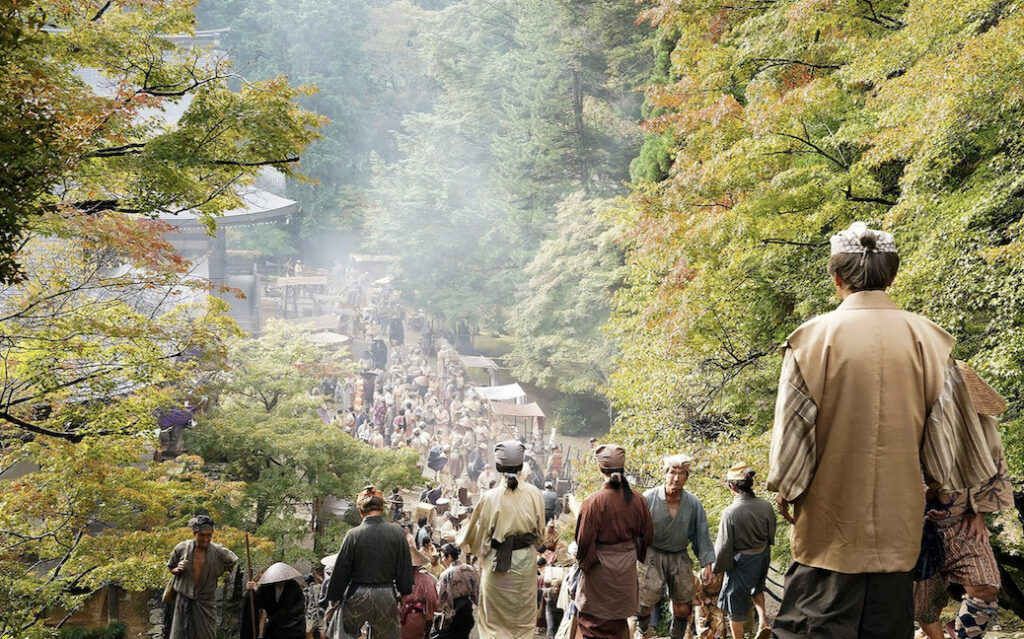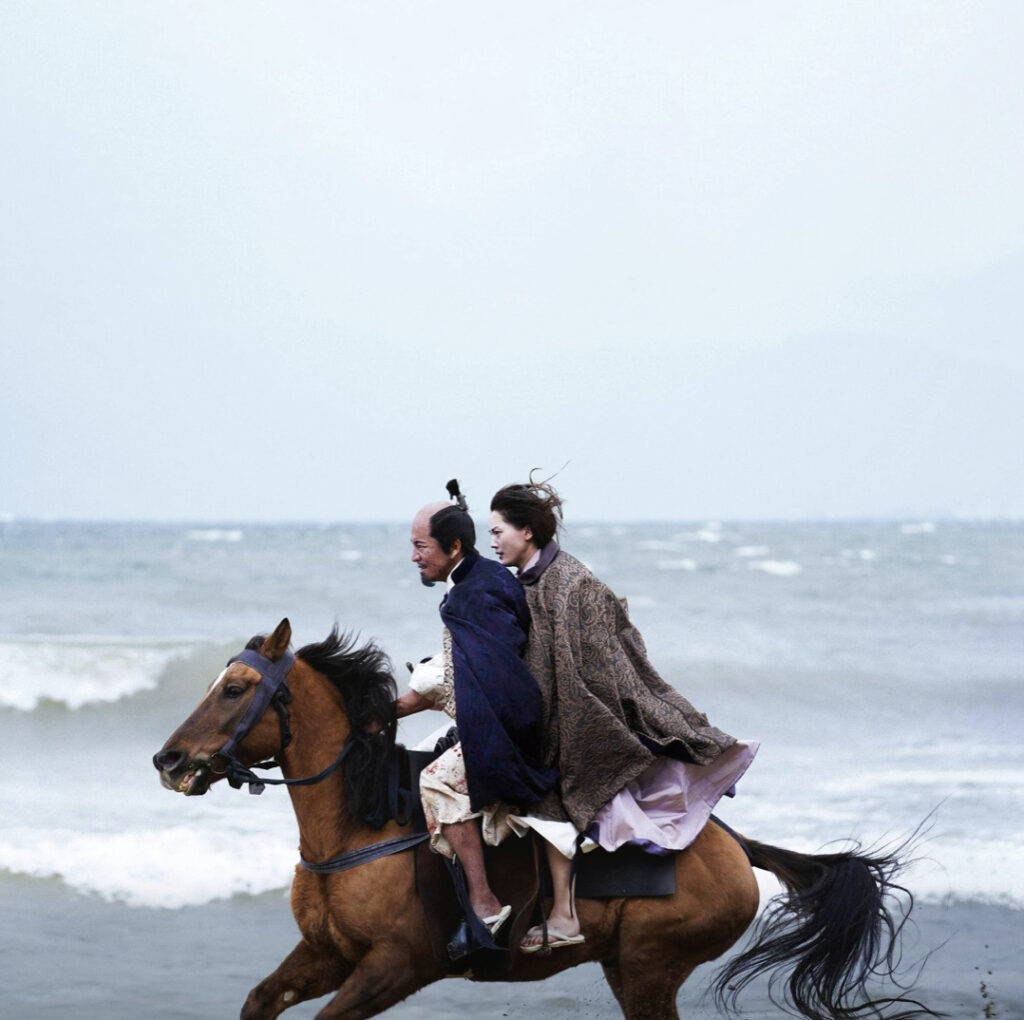
Synopsis : A sweeping historical romance created to celebrate Toei’s 70th anniversary, The Legend & Butterfly casts megastars Takuya Kimura as Oda Nobunaga and Haruka Ayase as his wife, Nohime. While Oda Nobunaga is one of Japan’s most well-documented historical figures, virtually no information about Nohime remains, and The Legend & Butterfly fills this mystery with a turbulent, thoroughly modern romance. A Sengoku era take on the expression “behind every great man lies a great woman,” The Legend & Butterfly sees over 30 years of defining moments in Japanese history driven by powerful, private moments between Nobunaga and Nohime.
Dir. Keishi Otomo, 2023, 168 min., DCP, color, in Japanese with English subtitles. With Takuya Kimura, Haruka Ayase.

Exclusive Interview with Keishi Otomo
Q: This film — produced at a budget of nearly 20 million dollars to commemorate the 70th anniversary of Toei’s productions — depicts warlord Nobunaga Oda’s turbulent 30+ years of life. The script was written by Ryota Kosawa, writer of the “Confidence Man JP” series in Japan — did he bring this project to you?
Keishi Otomo: Toei wanted to make a movie for the 70th anniversary of the company. Takuya Kimura and Haruka Ayase were already attached to it, and then they picked Nobunaga Oda as the subject of the story. Toei Studios had its roots in period dramas, but they hadn’t made a period blockbuster for almost 10 years. I’ve done the historical TV drama, “Ryômaden,” on NHK and that pretty much changed the style of historical dramas. After that, I made the “Rurouni Kenshin” film series. Since then, I thought that the Japanese style of action had changed a bit. So I decided to make a period drama film suitable for Toei’s 70th anniversary, as well as becoming Toei’s know-how and something to lead in the future.
Q: At that point, was the script already written by Ryota Kosawa?
Keishi Otomo: There was no script at that point. Toei wanted to celebrate the 70th anniversary with four important cards: actors Takuya Kimura and Haruka Ayase, screenwriter Ryota Kosawa and me. After that, Mr. Kosawa and I met, we had some communication about how it would be to depict Nobunaga Oda, and then Ryota Kosawa wrote the script.
Q: There aren’t many sources on Nōhime — even her name and title aren’t certain. She’s also called Kocho, Kicho/Kucho, and Nōhime. Did you refer to “Ehon Taikoki” [written in the mid-Edo period] Based on “Kawazumi Taikoki” [“The Taikoki of Toyotomi Hideyoshi”], it describes the life of Toyotomi Hideyoshi. The text was written by Takeuchi Shosai and was illustrated by Okada Gyokuzan. There are 84 volumes in seven editions or “Bussho Kanjoki” [a travelogue written about warriors from the Warring States Period to the early Edo Period]. It consists of 250 stories in 10 volumes. How much did you exchange opinions with Mr. Kosawa and what aspects of the work were fleshed out through your experience with period dramas?
Keishi Otomo: Mr. Kosawa originally wanted to do a “Boy Meets Girl” romantic comedy as a period drama rather than just the story of Nobunaga Oda and Nōhime. Then Toei came to him with the idea of depicting Nobunaga Oda. He told them that he wanted to do a romantic comedy about Nobunaga Oda and Nōhime. But in the Sengoku era, marriage was more like a political arrangement rather than a romantic one, a kind of hostage situation where the survival of the family and household was at stake.
If you become a member of a family, you wouldn’t easily turn your sword against your clan [family]. That feeling was present in period dramas, so I wondered if a romantic comedy would work where lives are at stake, with slashing and striking by the swords. Mr. Kosawa himself was also concerned about the comedy aspect. He wanted to work with a director who wouldn’t make his romantic comedy too frivolous.
Since my directing style favors realism and a gritty storyline, I also felt that when discussing this film. I was hoping that the awkwardness of two young people meeting for the first time on their wedding night would be naturally funny. I talked with Mr. Kosawa about how to make the audience laugh and how to film the period without being too concerned with the comedy and so on. The film was the result of that.

Q: The acting of Ms. Ayase and Mr. Kimura is exquisitely timed and very comical. When it comes to the dramatic part, the acting between them was amazing.
Keishi Otomo: That’s right. If we only focused on making things funny, it would come off as frivolous, but both of them are solid actors, and if we did it in a natural way rather than trying to make people laugh, the audience would apply their own thoughts and experiences, including the drama of a man and woman on their first night together, and they would laugh. I was conscious of not going out of my way to make people laugh or exaggerate too much.
Q: The theme of the film is about a married couple, but in the past, you used long shots in the “Ryômaden” TV drama series. In the “Rurouni Kenshin” film series, you used a high-speed action style. Did you take a different approach from the past in terms of technique in creating this film?
Keishi Otomo: The technical aspect was not so important. It was just a matter of putting the maximum of what we had accumulated into this project. Nowadays, it’s very difficult to make period pieces, so the mainstream [way] is virtual in-camera, where there’s a new system of so-called LEDs. After Covid, it’s still difficult to go outside, and budgets have ballooned. This virtual way of creating works without going on location as much as possible is gradually appearing in mainstream productions.
Period dramas, in particular, require a lot of time and effort, including costumes, and cost a lot of money if they go outside. Such a method has become mainstream after Covid, so I decided not to use such a method this time. The staff has already used very good locations in Kyoto that are national treasures. At a time when Kyoto was struggling to survive because of the pandemic, where there are very few tourists in Kyoto, Kyoto’s temples and other places of worship had reduced their fees.
There really are no more tourists in Kyoto. It was right around that time of year, so for the first time they were able to rent us locations that they would never normally rent to us, such as national treasure temples and other places. Takuya Kimura would get very excited if he stepped into such a place and shot where he would not normally be able to shoot. Haruka Ayase was excited to be allowed to shoot in such a place. So, before this period drama became a virtual world, I thought that this might be the last time we could do this kind of big budget film.
I dared to go into a real place and invite 300 to 500 extras instead of using VFX or CGI. For an 8 a.m. shoot, We actually had 300 to 500 people and started at 2 a.m. in the morning. The costume department had to prepare wigs, and it was extremely difficult. In the golden age of Japanese cinema, such things were done on a daily basis. Nowadays, however, due to various problems such as working hours, it’s not so easy to do.
If you try to do it properly, it costs a lot of money. So, in order to make it more compact and efficient, we would just lock ourselves in the studio and do everything inside it. However, there is a huge difference between that and having the actors go to a real place. For example, a story set in New York and shot entirely in Japan would be totally different. This time, I tried to stick to an orthodox way of making a film, a way that’s been done since the origin of cinema. We did not use any new technology, but rather, tried to stick to the traditional method of carefully making each scene one by one with our own hands.
Q: Takuya Kimura once said in an interview that no matter what role he plays, he was always told by people that he is Takuya Kimura, and was concerned about that. It’s because he takes on every role as if it were his own. When he plays the lead, other actors playing the supporting roles become extremely motivated and enthusiastic. What do you think about his impact?
Keishi Otomo: Mr. Kimura’s focus is extraordinary. He’s a star, so he can’t make a mistake — expectations are high. Oda Nobunaga is a historical figure from hundreds of years ago, and is still the No. One charismatic warlord in the Sengoku era [in history]. Mr. Kimura is a charismatic figure in Japanese entertainment from the last few decades.
So, he was very enthusiastic about the idea of creating a film combining two charismatic figures. Kimura turned 49 years old when we were shooting, the same age when Nobunaga Oda passed away, so I felt a great sense of attachment to him. I had heard rumors about Kimura, but he really came to the set before anyone else, to see for himself what kind of props were there.
He would go in to see what kind of place he was going to play in. I called it a ritual [laughs.] In the course of such preparation, he remembered all the lines, and almost never made any mistakes. When he was on set, he looked at the staff intently. There was this kind of tension, and the staff was all terrified, but I was comfortable with that. I felt that he must have been at the top of his game for decades with that approach. He really looks at the film as a whole, so he’s particular about his collaboration with the cast and crew. That kind of determination and focus is what makes him different from others.

Q: In the film, Nobunaga seemed to have been a visionary in many ways, such as wearing a short hakama and rope around his waist, listening to nanban [foreign] music, eating konpeito [small colored sugar candy], hiring a black samurai Yasuke, etc. What’s your view of Nobunaga? At the time, he was called a “Utsuke [fool]” and he became a “Maou” [Prince of Darkness].
Keishi Otomo: Basically, as with “Ryômaden” and ‘Kenshin” in “Rurouni Kenshin,” when I dealt with historical figures, I didn’t want to put them on a pedestal and worship them as great people. I wanted them on the same level as me. Nobunaga is a charismatic figure in Japanese history, so there are many episodes about him that say he was amazing. Nobunaga was very innovative, but at this time, I wanted to show that, although he was strong, he had both strength and weakness.
I wanted to incorporate his hesitation and weakness behind his character in the film. I always thought that this was the way to properly depict a historical figure. I don’t want to depict Isoroku Yamamoto [Marshal Admiral of the Imperial Japanese Navy] or anyone else as just a great person. They should be the same person like me — they made mistakes. They are fêted because of good fortune but even such a great person, when he goes home, his wife might be wearing pants around the house, or his daughter may say, “Dad, you’re dirty.” You never know.
I also discussed with Mr. Kosawa and Mr. Kimura about how we wanted to show Nobunaga’s weakness and humanity. We incorporated this into how he was in real life. In Japan, when we study history, Nobunaga was a great pioneer, a revolutionary, a great leader, and an amazing hero who united Japan in that era. But even so, he had his doubts and weaknesses, and sometimes his wife, Nōhime, was angry with him. Even if he really wanted to say something, he couldn’t even say, “I love you.” That was not the way things were in that era. I wanted to make sure that Nobunaga also had a human heart and emotions. Rather than make Nobunaga the extremely charismatic [icon he’s known as], I’m trying to bring him down [to earth].
That’s exactly how we staged the Honnoji Incident. During the Honnoji Incident, Mitsuhide Akechi’s army suddenly attacks, and in the story of Nobunaga so far, Nobunaga doesn’t get off the handrail much. He always looks down on his enemy from above. In the past, in the stories of Nobunaga, he’s not been so much down from the handrail; he’s always looked down at his enemies from above. Nobunaga is dragged down from the handrail of Honnoji Temple, covered in mud, still fighting.
In this way, he reveals the part of him that still wants to live and doesn’t want to die. In previous films, Nobunaga had given up and gone to the back room to die by stabbing into his stomach [seppuku]. As it’s said, “A human being has 50 years to live.” But in this film, Nobunaga was living a fantasy of what he would have done had he lived to the end. I think most people are like that. There are few people who, on the verge of death, can say that their life was the best they ever lived. But I wonder if that’s the case except for a guy like Shohei Otani [the MLB baseball player].
Q: Nobunaga’s strength and weakness are portrayed in a way that Nōhime really understood. What was the rehearsal process you went through to create such an acting dynamic?
Keishi Otomo: Both of them already had careers and good instincts, so it was important [for them] not to think about the other’s performance, so that they could work together. It was based on the idea of understanding the other person. Even if the two would clash, they would discover something, and say, “This is what I think” or “No, that’s not what I think.” In the latter half of the story, however, Nobunaga becomes more and more influential, and the balance between the two is disrupted.
He stops listening to what she says. What I was conscious of, especially in the first half of the film, was not to pile on the other, but to leave the impression that they are all putting on their own performance, and that they are all hitting each other. I wanted to make sure that the communication was not so much about understanding each other as it was about communicating what I wanted to say and what I was thinking. In that sense, at this level, there was no need for repeated rehearsals and explanations. We just went through the performance repeatedly on set, whispering little hints to each other and checking as we went along.

Q: You shot the film at Toei’s studio and in other locations as well. What did you pay particular attention to in terms of the backgrounds and action scenes, especially the Honnoji Incident [the assassination of Japanese daimyo Oda Nobunaga at Honnō-ji temple in Kyoto on June 21, 1582 A.D.] and the scenes shot at the burning of Enryakuji Temple on Mt. Hiei aka Hieizan [Nobunaga forces set fire to Enryaku-ji and massacred the monks in the Siege of Mount Hiei 1571].
Keishi Otomo: Hieizan has been in existence for hundreds of years, but Nobunaga’s burning of Hieizan was the first time the candles —which had been lit all along — went out after Oda’s army attacked the temple. The lights of the turrets, which had been burning for a long time, were extinguished for the first time, as were the many temples and places where candle lights were dispersed throughout Japan. There are many temples of people who fled from Hieizan. Hieizan was the biggest anti-political power in that period.
A very large portable shrine was brought down from Hieizan to Lake Biwa in Shiga Prefecture, and a huge number of monks with monstrous strength from Hieizan were said to be doing “wasshoi, wasshoi, wasshoi [the distinctive chant. Heard at many festivals across Japan]. It’s said that this was an act of intimidation to show that they had great power. If you look at old documents, you’ll find that the Hieizan priests were doing this intimidating behavior a lot.
Nobunaga felt pressured by this, and in fact, religious forces were very strong when it came to controlling the land and country back then. In the action scene at Honnoji Incident, we wanted to show the priests as a strong force, not as a group of roaming foes that would be swept away by Nobunaga’s army, but as an opposing force against Nobunaga. I wanted to depict that the first scene was that of the Nobunaga’s forces being beaten up in a realistic manner, so I arranged strong action people on the priests’ side and created the sword fight scenes.
There’s a pagoda in the middle of Honnoji Temple and a staircase there. Normally, they wouldn’t let us set a fire near a national treasure, but since it was the first time, we were allowed to set a Goma fire. Under the fire, a battle was going on, and the monks were waiting from above. The scene at Enryakuji Temple on Hieizan was intended to show that Oda’s army was having a hard time attacking the temple, because of the arrows and trees falling on them.
The battle was between Oda’s army of 20 to 30 peasants and Akechi’s army of 10,000. In previous productions depicting Nobunaga, he quickly escapes to the back of the room, and the audience knows the conclusion. Nobunaga dances “Atsumori” and performs harakiri. The direction leading up to it is something the audience looks forward to, but this time, I won’t let him go easily to the back room. I want to fulfill the promise I made to Nōhime earlier. If there’s a loved one in a condition like that, it means that everyone was fighting in thinking about their loved one. That’s what Nobunaga was thinking.
I wanted to depict Nobunaga’s persistence to live to the end, [and show] his refusal to choose death easily in such an environment, as he struggled to find a way out of the situation. He sticks to that, and from there, the enemy’s army made him more desperate. But still, Nobunaga has the will to keep fighting even if he is alone. In the midst of all this, star Takuya Kimura plays Nobunaga as he falls to the ground. Oftentimes, Mr. Kimura plays a very cool Nobunaga. I thought it was the perfect opportunity to create a situation where Mr. Kimura, who plays a Nobunaga covered in mud, is really dirty.
Just as I had Masaharu Fukuyama of the TV series “Ryômaden” covered in mud from the very first episode, I thought that even if something beautiful gets dirty, the beauty doesn’t disappear. If we are shy about it and try to make it shiny or flattering, the work will not be good. I believe that the dirtier a star gets, the brighter he or she shines. This time, Mr. Kimura was aiming to make it as dirty as possible. In staging the final scene at Honnoji Temple, Takuya Kimura’s intention — as Nobunaga — emerged as he was trying various things to hold back the army that was rushing in. He cut off the head of a man and lifted it up. I thought, “Let’s go all out at Honnoji. I don’t think I’ve ever seen such a brutal Takuya Kimura performance.”

